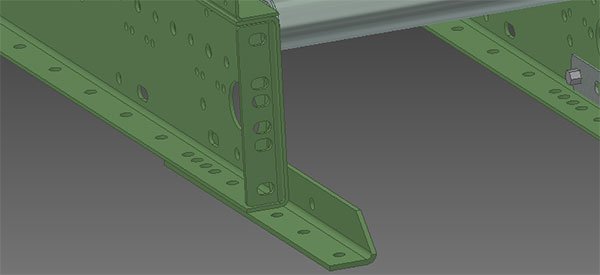
3 Space-Saving Conveyor Support Alternatives
Wade Brown | 21 September 2017
When floor space is running low, here are three ways to re-capture square footage with conveyor support alternatives.
In today’s distribution centers, open floor space is extremely important as it allows unobstructed travel for fork lift trucks, and even more importantly, safe passages for personnel to move around the facility. However, as volume and throughput demands increase in today’s distribution centers, the complexity of the conveyor system also increases. Conveyors are often routed through all parts of a facility at various elevations. Supporting these conveyors while maintaining the previously mentioned floor space and walk ways creates a unique challenge.
This article examines three alternative methods for supporting conveyors when traditional floor and ceiling supporting is not an option.
STRONGBACKS
Strongbacks are a simple and economic form of under trussing a conveyor joint, allowing for the removal of a floor or ceiling support. Most conveyor manufacturers produce conveyor sections in lengths of 10-foot increments, which generally dictates a support at every conveyor section joint. With that in mind, it is easy to see that it does not take very much to have the floor covered with a forest of supports making passage impossible, or a ceiling so dense with hangers that access to equipment becomes impossible.
To lessen this congestion, strongbacks can be used every 20 feet, cutting the number of supports required in half. Basically, a strongback is a 9-foot long bare conveyor section that bolts to the underside of the main conveyor frame. The strongback should be centered at the bed joint with approximately 4'- 6” on either side of the joint. Strongbacks do have a draw back in that they cannot be used in conveyor sections that have a drive assembly attached.
JOINT SUPPORT ANGLES (Internal or External)
 Joint support angles work on a similar principle to strongbacks, however, placement and capacity of joint support angles are significantly more limited. Joint support angles are typically used when conveyor supports cannot be placed exactly at the bed joint. This could be due to panel point locations in the roof structure or interferences on the floor. The joint support angle allows the conveyor support to be located up to 12” away from the bed joint on either side. The joint support angle is bolted to the channel either internally or externally providing support at the bed joint.
Joint support angles work on a similar principle to strongbacks, however, placement and capacity of joint support angles are significantly more limited. Joint support angles are typically used when conveyor supports cannot be placed exactly at the bed joint. This could be due to panel point locations in the roof structure or interferences on the floor. The joint support angle allows the conveyor support to be located up to 12” away from the bed joint on either side. The joint support angle is bolted to the channel either internally or externally providing support at the bed joint.
UNDER TRUSSING
 Under trussing has been used over the years for many applications including bridges, structures, and roofs to name a few. This principle can be used to replace both floor and ceiling supports to create more of an open area where required. As can be seen in the illustration above, conveyor under trussing allows you to span much greater distances without the need for floor or ceiling supports. Besides freeing up valuable floor space, under trussing has the advantage of supporting conveyor bed sections that include a drive.
Under trussing has been used over the years for many applications including bridges, structures, and roofs to name a few. This principle can be used to replace both floor and ceiling supports to create more of an open area where required. As can be seen in the illustration above, conveyor under trussing allows you to span much greater distances without the need for floor or ceiling supports. Besides freeing up valuable floor space, under trussing has the advantage of supporting conveyor bed sections that include a drive.
If you're planning a conveyor system project and aren't sure what options are best for your needs, contact us. Our experienced engineers are happy to help you make the right choice.
As a project engineer supporting Bastian Solutions systems, Trey helps design and engineer various material handling systems including goods to person technologies. He also supports Bastian Solutions sales and installation teams with design concepts and site support.
Comments
No comments have been posted to this Blog Post
Leave a Reply
Your email address will not be published.
Comment
Thank you for your comment.